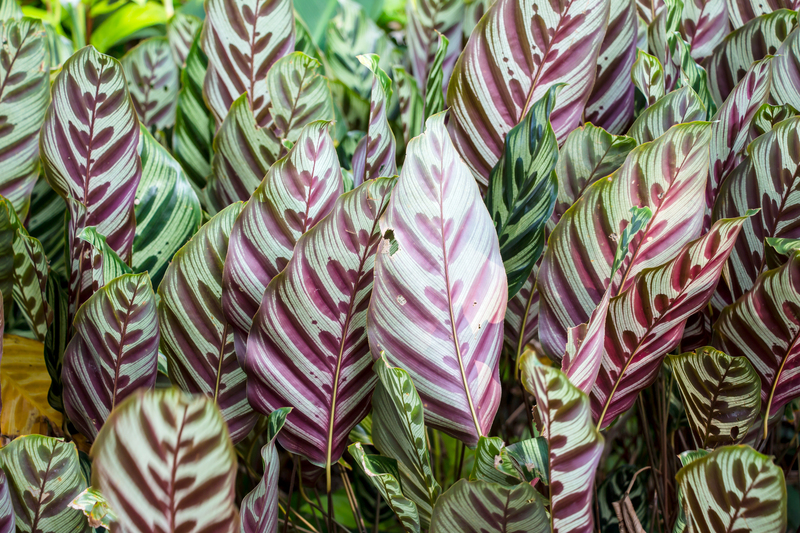Vertical Gardening: Nature's Vertical Canvas
Posted on 10/09/2025
Vertical Gardening: Nature's Vertical Canvas
Vertical gardening has transformed the way we interact with our environment, turning plain walls and empty spaces into thriving, lush ecosystems. Once considered a niche solution for urban spaces, vertical gardens are now celebrated worldwide for their aesthetic, environmental, and health benefits. In this guide, we'll explore vertical gardening in depth, uncovering its techniques, benefits, best plants, and creative ideas to help you create your own flourishing green wall--right at home.

What is Vertical Gardening?
Vertical gardening, sometimes referred to as living walls or green walls, is the art and science of growing plants upward rather than outwards. This practice utilizes vertical space--such as the sides of buildings, fences, balconies, and even indoor walls--to cultivate flowers, edibles, and foliage. Nature's Vertical Canvas is an apt description, as these gardens transform plain surfaces into vibrant, living artworks.
Key Features of Vertical Gardens:
- Space Optimization: Ideal for small or urban spaces
- Creative Expression: Turn walls into visually striking displays
- Improved Air Quality: Plants filter toxins and produce oxygen
- Insulation: Living walls provide natural temperature regulation
The Benefits of Vertical Gardening
More than just beautiful, vertical gardens offer a wide range of benefits. Let's delve into why this green innovation is gaining popularity among homeowners, city planners, and horticultural enthusiasts.
1. Maximizing Limited Space
One of the greatest advantages of vertical gardening is its ability to maximize space. If you live in an apartment or home without a backyard, you can still enjoy the calming benefits of a lush garden. Vertical planters, wall-mounted pots, and trellises all make small-scale gardening possible.
2. Environmental Impact
Living walls act as natural air purifiers. As plants photosynthesize, they absorb pollutants and carbon dioxide, releasing fresh oxygen. In urban environments, vertical gardens mitigate the urban heat island effect, reduce noise levels, and provide critical habitats for birds and beneficial insects.
3. Health and Wellbeing
Studies have shown that proximity to greenery reduces stress, boosts mood, and enhances productivity. By bringing vertical gardens into your space, you create a tranquil, restorative atmosphere that nurtures both the body and mind.
4. Aesthetic Appeal
A well-designed living wall is a masterpiece that draws the eye and sparks conversation. From sleek modern arrangements to whimsical cottage styles, the options are only limited by your imagination. Your vertical garden can express your personality while increasing your property's value and curb appeal.
Types of Vertical Gardens
Before you begin your vertical gardening journey, it helps to understand the different types of structures and systems available. Below are the most popular approaches for transforming spaces with nature's vertical canvas:
1. Green Facades
Green facades consist of climbing or trailing plants trained to cover a vertical surface, such as trellises, wires, or mesh affixed to walls. Common choices include ivy, climbing roses, or jasmine. This method is low-cost and allows plants to root directly in the ground or in planters at the base of the wall.
2. Living Wall Systems
These are modular panels or trays affixed directly to walls, filled with a growing medium and planted with a variety of species. Living wall systems are often irrigated automatically and allow for intricate designs and plant placements. Examples include felt pocket panels, hydroponic systems, and recycled plastic modules.
3. Freestanding Vertical Planters
If wall-mounting is not an option, free-standing vertical planters are available in many shapes and sizes, such as tiered plant stands, stackable pots, or tall shelving units customized for greenery.
4. DIY Vertical Garden Ideas
- Pallet Gardens: Upcycle wooden pallets by attaching pots or filling with soil for an easy vertical planter.
- Hanging Shoe Organizers: Use canvas shoe organizers on walls or fences, filling each pocket with herbs or flowers.
- Stacked Pots: Arrange pots of increasing sizes in a stacked fashion for a cascading effect.
Choosing the Best Plants for a Vertical Garden
The success of your vertical gardening project greatly depends on plant selection. Consider light exposure, climate, irrigation, and your design preferences. Here are some top choices for different conditions:
Shade-Loving Plants
- Ferns (e.g., Boston ferns, Maidenhair ferns)
- Pothos
- Philodendrons
- Spathiphyllum (Peace Lily)
- Heuchera
Sun-Loving Plants
- Succulents (e.g., Sedum, Echeveria)
- Herbs (e.g., basil, oregano, thyme)
- Strawberries
- Lavender
- Petunias
Flowering Plants
- Begonias
- Impatiens
- Geraniums
- Lobelia
- Verbena
Edibles for Vertical Planters
- Lettuce and leafy greens
- Herbs (parsley, mint, chives)
- Chili peppers
- Tomatoes (compact varieties)
- Radishes and microgreens
Pro Tip: Mix plant sizes, leaf colors, and shapes for a visually dynamic display. Always group plants with similar water and light needs together.
How to Start a Vertical Garden at Home
Ready to transform your wall into a living canvas? Follow these steps to establish your own stunning vertical garden:
Step 1: Choose the Location
- Decide between indoor or outdoor spaces.
- Assess light levels--some plants thrive in full sun, while others prefer shade.
- Ensure there's an accessible water source for irrigation.
Step 2: Select Your Vertical Garden System
- Determine if you want a wall-mounted, free-standing, or hanging system.
- Factor in cost, ease of installation, and long-term maintenance.
- Buy a ready-made kit or get creative with a DIY project.
Step 3: Prepare the Structure
- Ensure the wall or frame is strong enough to support the weight of plants and wet soil.
- Install waterproofing layers if setting up indoors to prevent moisture damage.
- Attach planters or pockets, leaving enough space for air circulation and plant growth.
Step 4: Choose and Plant Your Greenery
- Pick a mix of trailing, upright, and compact species for visual interest.
- Use high-quality potting mix suited to your selected plants.
- Plant tightly, as vertical gardens often look best when lush and full.
Step 5: Establish Irrigation
- Automated drip irrigation systems are ideal for larger or outdoor walls.
- For smaller gardens, hand-watering may be sufficient. Ensure water can drain away to avoid root rot.
Step 6: Maintain and Enjoy
- Feed your plants with balanced fertilizer every few weeks.
- Prune regularly to maintain shape and encourage growth.
- Inspect for pests or diseases, treating promptly if needed.
- Change out seasonal plants for fresh color and variety.
Creative Ideas for Vertical Gardening
Looking for inspiration? Here are some inventive ways to use vertical gardens as nature's canvas:
1. Edible Living Walls
Grow fresh herbs, greens, and tiny vegetables within arm's reach of your kitchen. Not only do they look stunning, but they also elevate your cooking with homegrown produce.
2. Artistic Plant Murals
Arrange foliage and blooming plants in patterns, geometric shapes, or even company logos for offices and businesses--perfect as an eye-catching eco-friendly statement.
3. Privacy Screens
Use a freestanding vertical planter or wall-mounted system to shield your balcony or patio from neighbors while enjoying a touch of greenery.
4. Indoor Green Walls for Wellness
Install vertical gardens in workspaces, entryways, or living rooms to create a calming, refreshing atmosphere and improve indoor air quality.
5. Succulent Walls
Combine drought-tolerant succulents in a mosaic-style arrangement for low-maintenance, modern artworks that thrive in bright locations.
Common Challenges and Solutions in Vertical Gardening
While the rewards of vertical gardening are great, certain challenges do exist. Here's how to troubleshoot common issues:
- Watering Difficulties: Upper tiers may dry out faster than lower ones. Solution: Install a drip irrigation system and ensure water reaches every level.
- Structural Concerns: Wet soil and mature plants can be heavy. Solution: Reinforce walls and use lightweight growing mediums wherever possible.
- Pest Control: Crowded plants invite pests. Solution: Choose disease-resistant species and prune often to improve airflow.
- Nutrient Deficiency: Limited root space can lead to deficiencies. Solution: Feed regularly, and consider using slow-release fertilizers.
Vertical Gardening: Sustainability and the Future of Urban Spaces
The role of vertical gardening extends far beyond home decor. As urban areas grow denser and green spaces decrease, vertical gardens offer a sustainable solution. Architects and city planners are integrating living walls into high-rises, schools, hotels, and public spaces globally. These installations reduce city heat, sequester carbon, grow local food, and promote biodiversity--making cities greener, cleaner, and more humane.
Famous Examples of Vertical Gardens
- Musee du Quai Branly Living Wall, Paris: Designed by botanist Patrick Blanc, this iconic facade boasts over 15,000 plants.
- One Central Park, Sydney: A residential tower with 38,000 native Australian plants.
- The Bosco Verticale, Milan: Twin residential towers enveloped in over 900 trees and 20,000 smaller plants.

Vertical Gardening: Tips for Beginners
If you're new to vertical gardens, these beginner-friendly tips will give your green project a strong start:
- Start Small: Experiment with a few easy-care plants in a small wall planter before scaling up.
- Observe and Adjust: Monitor how your garden behaves in terms of sunlight and moisture, and make changes as needed.
- Mix Plant Types: For dramatic visual effect, combine climbers, trailers, and compact foliage plants.
- Don't Forget Design: Plan your layout like a painting--with foreground, background, symmetry or asymmetry, and color balance.
- Enjoy the Journey: Your garden is a living, evolving artwork. Celebrate its growth and transformation.
Conclusion: Embrace Nature's Vertical Canvas
Vertical gardening is more than a trend--it's an opportunity to reconnect with nature, no matter how small your space. Whether you're greening an apartment balcony, beautifying an office, or making a statement on your home's facade, you'll reap both aesthetic and practical rewards. Let your imagination soar as you experiment with nature's vertical canvas, and be part of the movement to bring vibrant, living beauty to every corner of our world.
Are you ready to create your own vertical garden and transform your wall into a living masterpiece? Start today--and watch as your vertical space bursts into lush, beautiful life.

